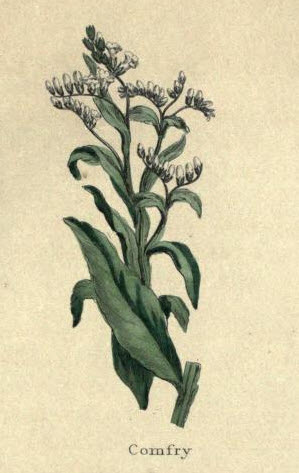
COMFREY
Comfrey Description:Symphytum Officinal. The common great Comfrey has large hairy green leaves lying on the ground, so hairy or prickly that if they touch any part of the body, they will cause it to itch. The stalk rises two or three feet high, hollow and cornered, and is very hairy. It has many such leaves as grow below, but decreasing in size to the top. At the joints of the stalks it is divided into many branches, with some leaves thereon, and at the ends stand many flowers in order one above another, which are long and hollow like the finger of a glove, of a pale whitish colour, after which come small black seeds. The roots are large and long, spreading large thick branches under ground, black on the outside, and whitish within.
Herbal Remedies and Medicinal Uses of Comfrey:What was spoken of Clown's Wound-wort, may be said of this. The Great Comfrey relieves spitting of blood, and bloody urine. The root boiled in water or wine, relieves inward hurts, bruises, wounds, and ulcers of the lungs, and loosens tough phlegm. It relieves those colds in the head which deposit rheum in the lungs; cures bloody flux, immoderate courses, the whites, and diseases of the kidneys. A syrup made thereof is effectual for all inward hurts, and for outward wounds and sores in the fleshy or sinewy part of the body. The roots are more effectual than the leaves. They are good for fresh wounds or cuts when bruised and laid thereon, and also for ruptures, and very powerful in knitting broken bones. It is an excellent remedy for sore nipples. The roots beaten small, and spread upon leather, and laid upon any place affected with the gout, immediately relieves the pains; also pained joints, and is very useful in moist ulcers, gangrenes, and mortifications.
Important Disclaimer:
The information contained on this web site is for educational purposes
only. It is not intended to diagnose, treat, or cure any diseases. Any
information presented is not a substitute for professional medical advice
and should not take the place of any prescribed medication. Please do not
use this information to diagnose or treat a health problem or disease
without consultation with your physician.
This page and the rest of the encyclopedia of medicinal herbs was reproduced from old herbals written in the 1700 and 1800s. They are of historical interest to show the traditional uses of various herbs based on folk medicine and ancient wisdom. However the traditional uses for these herbs have not been confirmed by medical science and in some cases may actually be dangerous. Do not use the these herbs for any use, medicinal or otherwise, without first consulting a qualified doctor. Browse Herbs Alphabetically: A B C D E F G H I J K L M N O P Q R S T U V W X Y Z |
Advertisement
|
||
|
|||
